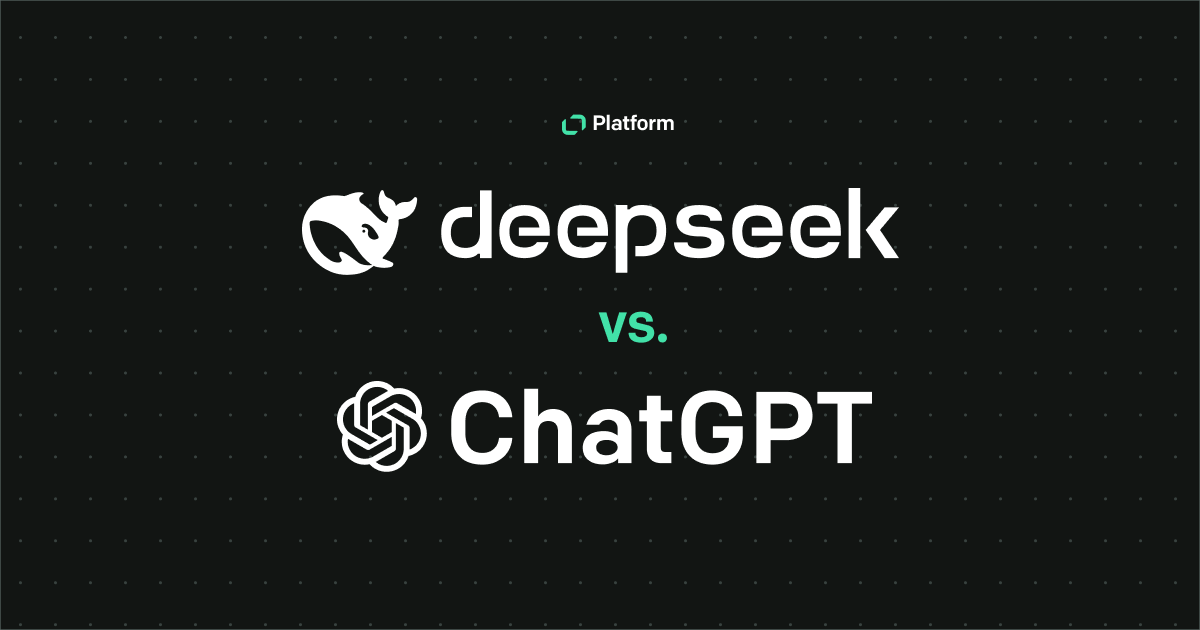Functional programming has surged in popularity recently, celebrated for its ability to produce robust, maintainable, and efficient software. But what exactly is functional programming?
This article will uncover the fundamental concepts, benefits, and challenges of functional programming and explore the languages that champion this paradigm.
What is functional programming?
The functional programming paradigm treats computation as evaluating mathematical functions and shuns changing states and mutable data. It emphasizes applying functions, standing in contrast to imperative programming, which focuses on state changes and executing command sequences.
Understanding functional programming can be a game-changer for developers aiming to write more predictable and bug-resistant code. The functional programming approach offers a pathway to cleaner, more reliable software that is easier to reason about and maintain.
Types of functions in functional programming
Functional programming is all about using different types of functions to craft clean, efficient, and expressive code. Most of what you know about composing functions, function calls, and nested functions from imperative or object-oriented programming remains the same for functional programming. Still, there are some key differences and additional concepts that enhance these capabilities.
Let's go over some of the main function types and concepts:
1. Pure functions
Pure functions are perhaps the most fundamental core concept in functional programming. Pure deterministic functions are ones that, given the same input, will always return the same output and have no side effects.
Calling a pure function with the same arguments will consistently produce the same result, regardless of when or where it is called in the program. The return value of pure functions depends solely on its input parameters, ensuring predictable and reliable behavior every time.
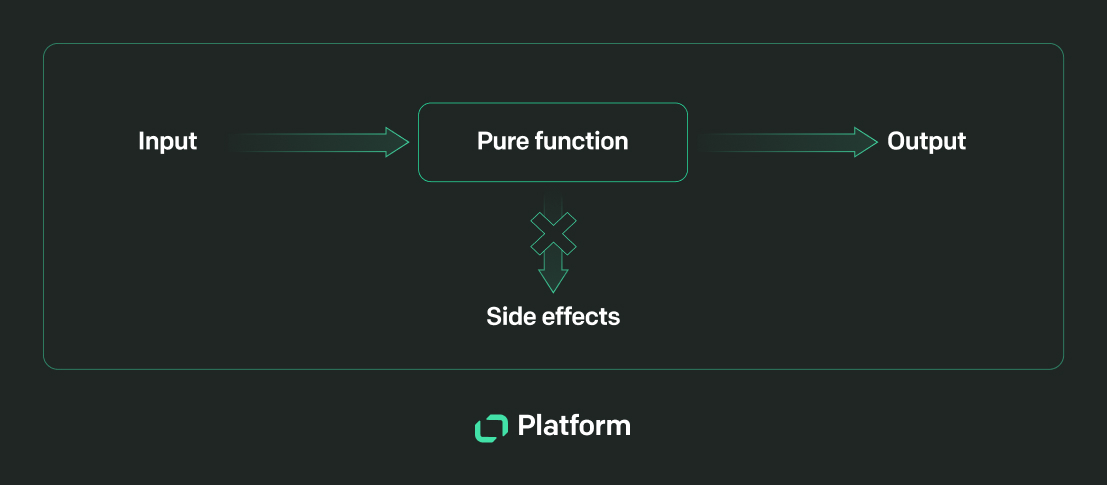
What about impure functions?
Impure functions, in contrast, have side effects or rely on external state. These side effects include modifying mutable data, performing I/O (input/output) operations, or interacting with the system environment. Because impure functions can produce different results for the same input, they are not referentially transparent and can be more challenging to test and reason about.
Impure functions are often necessary in practical programming, especially when dealing with I/O, stateful computations, or interactions with the outside world.
Pure function example
Let's look at an example of a pure function that converts Celsius to Fahrenheit:
This function is pure because, given the same input (a Celsius temperature), it always returns the same output (the corresponding Fahrenheit temperature). For example, celsius_to_fahrenheit(0) will always return 32.0. It does not modify any state or interact with external systems – it simply takes an input, performs a calculation, and returns the result. The output is entirely determined by its input, so calling celsius_to_fahrenheit(100) will consistently return 212.0.
2. First-class functions
In functional programming, functions are treated as first-class citizens. You can handle them like any other data type, opening up a world of possibilities for writing expressive, concise, and flexible code.
Here are the primary characteristics of first-class functions:
- Assign functions to variables – You can store functions in variables, making them easy to pass around and use dynamically throughout your program.
- Pass functions as arguments – Functions can be passed as arguments to other functions, which allows for high levels of abstraction and code reuse.
- Return functions from functions – Functions can return other functions, enabling you to create function factories and higher-order functions.
3. Higher-order functions (HOF)
A higher-order function is a function that takes one or more functions as arguments, returns a function, or both. They’re incredibly powerful for creating more abstract and reusable code. HOFs can:
- Accept functions as arguments – You can pass functions as arguments to other functions, perfect for mapping, filtering, and reducing data.
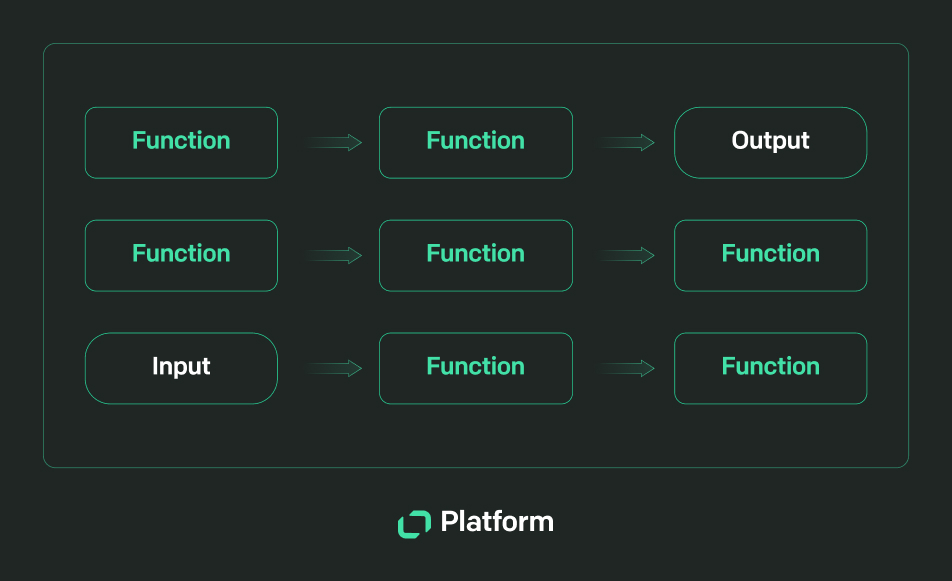
- Return functions – HOFs can also return new functions, allowing you to create functions on the fly. You’ll find it useful for patterns like currying and partial application, where you customize functions by pre-filling some arguments.
- Combine functions – You can use HOFs to combine multiple functions, building more complex behavior from simpler components, leading to cleaner, more modular code that’s easier to maintain and understand.
4. Lambda expressions
Also known as anonymous functions, these expressions let you define and use functions on the fly without needing to name them. They are particularly useful for small, short-lived functions used only in a limited scope, such as arguments to higher-order functions.
More need-to-know concepts of functional programming
To truly grasp functional programming, it's important to understand several more core concepts:
Immutable data
Immutable data refers to data structures that can't be altered once they're created. In other words, once you assign a value to a variable or store it in a data structure, it's set in stone.

Functional languages have built-in support for immutable structures like lists, sets, and maps. These structures handle updates efficiently by creating new versions with the updated values instead of changing the original data. This method, called structural sharing, allows the new data structure to share parts of the old one, reducing memory usage and minimizing copying overhead.
Immutable example
For instance, in a functional language like Haskell, you can define a list like this:
Here, myList is an immutable list containing the elements 1, 2, 3, 4, and 5. Once defined, you can't change its contents.
Instead of using assignment statements to update variables, functional programming encourages the use of new variables to hold updated values, preserving the immutable values. Any variable can be substituted with its actual value at any time during execution, eliminating the risk of side effects.
If you want to add a new element to this list, you would create a new list with the additional element rather than modifying the existing list:
In this example, newList is a new list that contains the elements 1, 2, 3, 4, 5, and 6 while myList remains unchanged, ensuring that the original data remains intact and preserving the integrity of the program's state.
Lazy evaluation
Lazy evaluation, or call-by-need, is an approach some functional programming languages use where expressions aren’t evaluated until you actually need their results. Computations are delayed until their values are required somewhere in your program.
Lazy evaluation can be a game-changer when dealing with costly computations that might not even be needed. It boosts performance and makes it possible to work with infinite data structures effortlessly.
Memoization
Memoization is like your program’s memory bank for expensive function calls. It stores the results of these calls so that the next time the same inputs show up, it can quickly return the cached result instead of recalculating it. While overall efficiency is enhanced, computational costs can also be dramatically cut down.
Recursion
Functional programming often relies on recursive functions, which call themselves in order to solve problems, making it a natural fit for many functional programming languages that lack traditional looping constructs like for or while loops.
Pure functional programming languages
Functional programming has inspired the creation of several languages, each with its own unique approach to supporting functional programming concepts. These languages have been used to develop a wide range of software, from web applications to scientific simulations:
Haskell
Haskell is a pure functional language, meaning that its functions have no side effects and always produce consistent results for the same input. This makes Haskell code easier to reason about and test.
In web development, frameworks like Yesod and Snap leverage Haskell's strong typing and concurrency capabilities. In finance, companies such as Standard Chartered and Barclays use Haskell for its reliability and precision in handling complex financial algorithms.
Lisp
Lisp is one of the oldest functional programming languages and supports functional and imperative programming paradigms. Lisp is known for its powerful macro system and flexibility, allowing developers to extend the language with new constructs and abstractions. Lisp has been used in a wide range of applications, including artificial intelligence, video games, and software development tools.
Erlang
Erlang is designed for concurrent and distributed systems, and its functional nature makes it well-suited for building reliable and scalable applications. Erlang's lightweight process model and message-passing concurrency model allow developers to easily build highly concurrent systems.
Erlang's focus on fault tolerance and hot code swapping makes it one of the most popular functional programming languages for telecommunications and real-time systems.
Impure functional languages
In addition to the languages mentioned above, several other functional programming languages support functional programming to varying degrees. These other languages include:
JavaScript
While primarily an imperative language, JavaScript supports functional programming concepts such as first-class and higher-order functions, leading to the rise of functional programming libraries and frameworks in the JavaScript ecosystem, such as React and Redux.
Python
The Python programming language supports functional programming alongside imperative and object-oriented programming. Python's functional features, such as lambda functions and list comprehensions, are widely used in data science, web development, and automation.
Scala
Scala is a hybrid functional and object-oriented programming language that runs on the Java virtual machine (JVM). Scala combines the best of both paradigms, allowing developers to write concise, expressive code while leveraging the vast ecosystem of Java libraries. Scala is used in big data processing, web development, and finance.
Five advantages of functional programming
Functional programming offers a variety of benefits that make it an appealing option for many software development projects. Here are some of the key advantages of functional programming:
1. Predictability and reliability
One of the hallmarks of functional programming is the use of pure functions, which offer predictability. Your code will be more reliable and easier to debug since no hidden dependencies or state changes can introduce unexpected behavior.
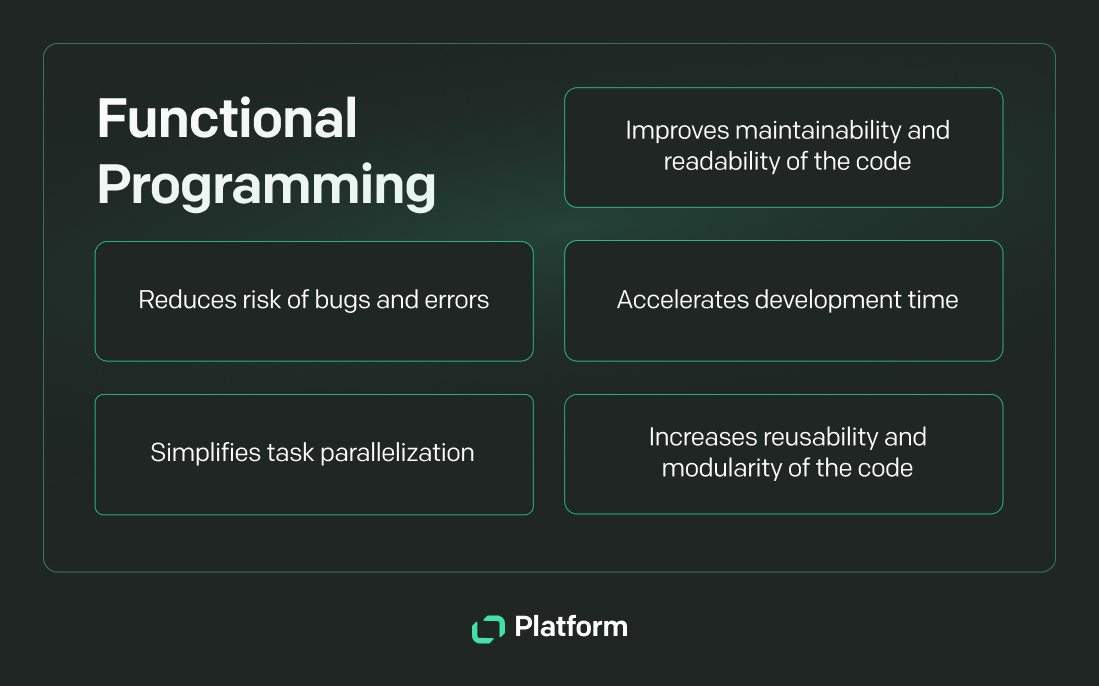
Furthermore, these deterministic functions can be replaced with their corresponding value without changing the program's behavior. The property known as referential transparency simplifies reasoning about your code and enables powerful optimization techniques by compilers.
2. Maintainability and readability
Immutability makes it easier to understand and manage your program's state, eliminating bugs caused by unexpected changes. With immutable data, you can easily grasp what your functional programs do and keep track of the state without surprises.
It also encourages breaking down problems into small, reusable functions. These functions can be combined and reused throughout your programs, making your code more modular and easier to maintain.
3. Supports parallel programming and concurrency
It is easy to break down computations into independent tasks that can run in parallel, boosting performance on multi-core processors. You can effortlessly write efficient, scalable code that takes full advantage of modern hardware.
You also don't have to worry about mutable state, which means your code is naturally thread-safe. Your data remains unchanged, even when accessed by multiple threads, eliminating race conditions and making concurrent programming simpler and less error-prone.
4. Reusability and abstraction
You can pass functions as arguments, return them from other functions, and assign them to variables. This flexibility is at the heart of higher-order functions and enables you to create more generic and reusable components. You can also compose functions to build complex operations from simpler ones – making it easier to construct sophisticated behaviors by combining small, well-defined functions.
5. Mathematical foundation
Functional programming is rooted in lambda calculus, a formal system developed by Alonzo Church. Lambda calculus provides a strong theoretical foundation for each popular functional programming language, enabling precise reasoning about functions, their composition, and behavior. Mathematical underpinning of this type can lead to more rigorous and robust software development practices.
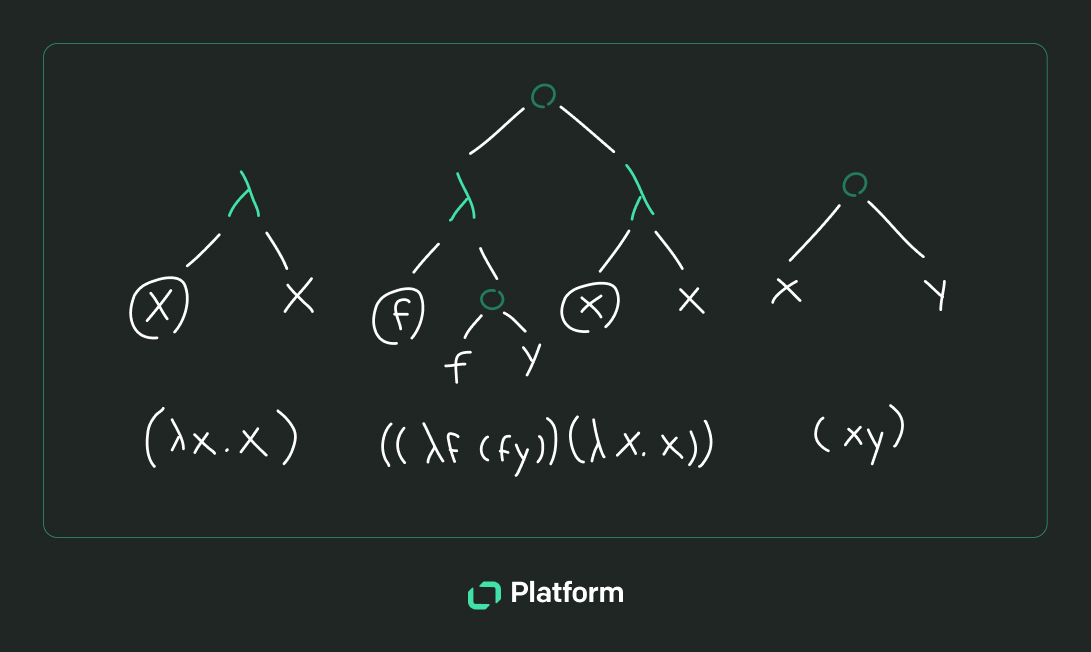
Five disadvantages of functional programming
While functional programming offers many benefits, understanding its drawbacks is essential for developers considering this paradigm:
1. Steep learning curve
One of the biggest challenges with functional programming is its steep learning curve. Switching to functional programming can be tough if you’re used to imperative or object-oriented programming.
The core concepts require you to think about problem-solving and program structure in a whole new way. Functional programming requires mastery of these ideas, which takes time and effort. This can be a hurdle for teams or organizations that don't have extensive training resources.
2. Performance overheads
Creating new versions of data structures instead of modifying existing ones can lead to increased memory usage and slower execution times.
While structural sharing and optimizations like tail call optimization can mitigate some of these issues, they do not entirely eliminate the overhead. These overheads can be a significant concern in performance-critical applications, such as real-time systems or high-frequency trading.
3. Limited library and framework support
Functional programming languages often have fewer libraries and frameworks than imperative and object-oriented ones. This can make integrating with existing systems or using third-party tools harder.
For example, while JavaScript and Python offer extensive libraries and frameworks for web development, data analysis, and machine learning, purely functional languages like Haskell or Erlang may have fewer options. Such a limitation might require extra effort to build or adapt tools to fit functional paradigms.
4. Integration with imperative codebases
Integrating functional programming with existing imperative or object-oriented codebases can be tough. Different paradigms require different design and implementation approaches, making seamless combinations challenging. As developers would have to bridge the gap between functional and non-functional code, mixed-paradigm projects can have increased complexity.
5. Verbose syntax and complexity
Functional programs sometimes have a verbose syntax or require more intricate constructs for certain tasks compared to programs written in imperative languages. Such code could be harder to read and understand, especially if you're unfamiliar with functional programming.
For instance, simple loops might turn into complex recursive solutions or higher-order functions, which can feel less intuitive and more challenging to work with.
Functional programming in the industry
Functional programming concepts can be applied to various domains, from web development to machine learning and artificial intelligence. Here are some practical applications:
- Application in software development – Functional programming shines in financial systems and complex applications where precision and reliability are crucial. For instance, Haskell is used by banks like Standard Chartered to build reliable and maintainable trading systems, while Erlang was used to power the fault-tolerant messaging platform WhatsApp.
- Web development – Functional programming concepts such as immutability and pure functions are used to build robust and maintainable web applications. For example, Elm, which provides a strong type system and a purely functional approach to web development, leverages these principles.
- Machine learning and artificial intelligence – Functional programming is well-suited for AI, machine learning, and deep learning due to its emphasis on mathematical functions and immutability. Haskell is used to research and implement ML algorithms in academia and industry. Scala, with frameworks like Spark, allows for efficient data processing pipelines. This enables companies like LinkedIn to perform large-scale data analysis and machine learning tasks.
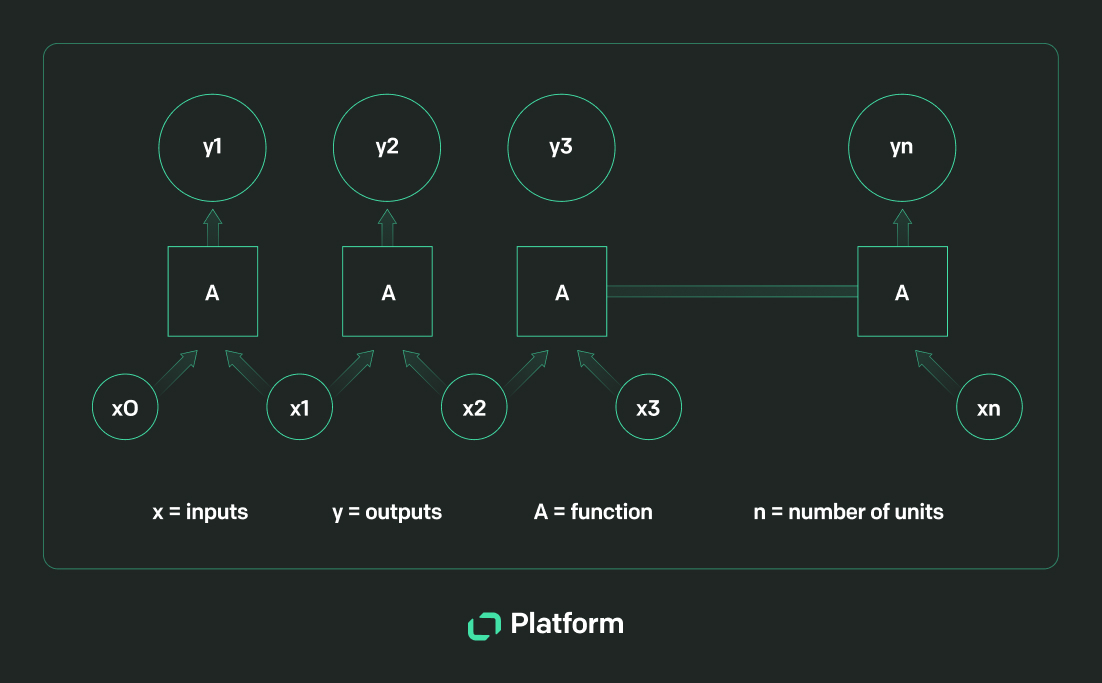
- Mobile and full-stack development – Functional concepts are increasingly being incorporated into mobile and full-stack development. A full-stack developer can leverage React Native to build mobile apps using a functional approach. Similarly, full-stack frameworks like Next.js embrace functional principles, offering a seamless development experience that spans both front-end and back-end.
- Language processing – Functional programming is great for language processing tasks such as compilers and interpreters. The LLVM compiler framework, written in functional languages like OCaml, optimizes code generation and analysis.
Empower your development with functional programming on the Text Platform
Functional programming can transform your development process on the Text Platform, making your code more predictable, reliable, and maintainable. Leverage our APIs and SDKs for chat messaging, reports, and configuration to build robust applications that integrate seamlessly with our technology.
The Text Platform's APIs allow for various text operations, giving you a solid foundation for innovative solutions. With our extensive technology stack, you can extend industry-leading products like LiveChat or develop solutions for HelpDesk.

Adopting functional programming principles can improve the maintainability and scalability of your applications. It can also help you manage state more effectively and write cleaner, modular code—ideal for creating complex integrations or custom solutions.
Embrace functional programming on the Text Platform to create high-quality applications, expand your reach, and connect with a broad audience.


